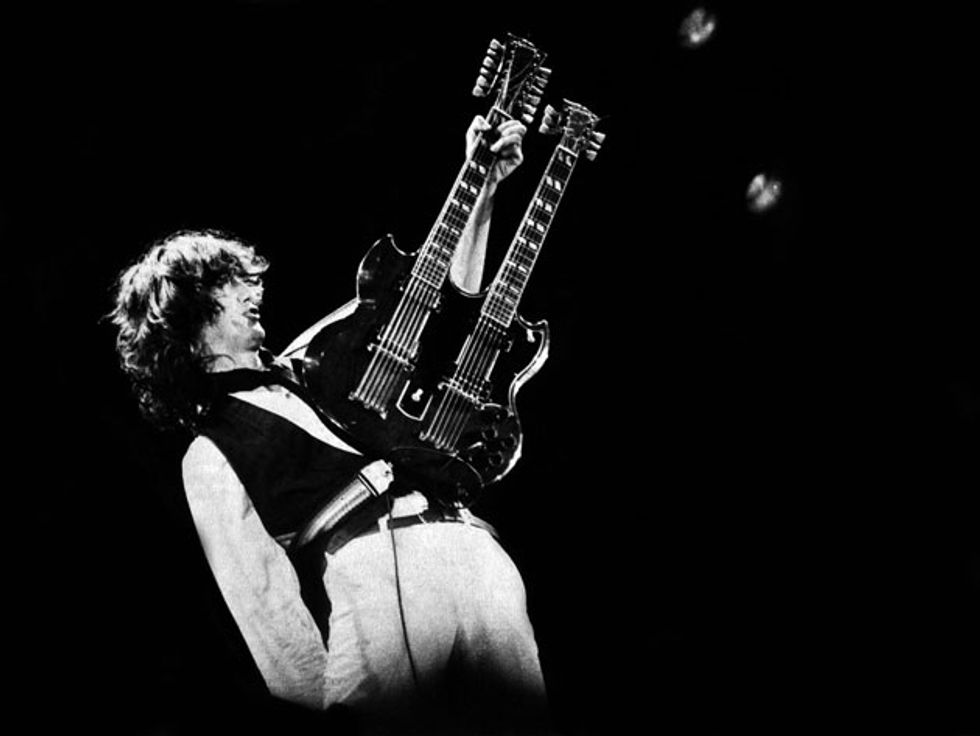Chops: Intermediate
Theory: Intermediate
Lesson Overview:
• Learn how to play “over” the time while focusing on feel.
• Create phrases that cycle six notes over a 4/4 groove.
• Understand how Page used dynamics and improvisation in Zep’s live shows.
Click here to download a printable PDF of this lesson's notation.
As one of the quintessential live bands of the ’70s, Led Zeppelin always gave their classic songs a unique spin onstage. Jimmy Page’s ability to expand, develop, and reinvent his already iconic guitar solos was always a highlight of any Zep show. In this lesson, we’ll investigate trademark elements of Page’s live approach and draw inspiration from such live Zep recordings as The Song Remains the Same and How the West Was Won.
The studio version of “Whole Lotta Love” was baked in riffed-out glory along with Theremin and vocal effects, but when performing it onstage, Page took the opportunity to stretch the five-minute song into something much longer. Here, we’re not actually dealing with “Whole Lotta Love” at all—the band used the middle section to explore classic rockabilly and blues themes.
YouTube It
Clocking in at just over 23 minutes, this version was recorded at the L.A. Forum on June 25, 1972. The whole middle section is a medley of sorts with the band touching on “Boogie Chillun,” “Let’s Have a Party,” and a few more.
This simple lick (Ex. 1) is in the spirit of the improvised call-and-response phrases Page and Plant would exchange in a slow, free tempo. Use an overdriven British amp setting, but dial back on your guitar’s volume knob to clean up the tone a bit.
Click here for Ex. 1
A call-out to either Eric Clapton or Freddie King, Ex. 2 is a Page-like take on a ferocious blues break that features an E9 chord and sliding double-stop sixths. Pay attention to the alternate picking markings—they’ll help you shift smoothly between notes on the low and high strings.
Click here for Ex. 2
Rockabilly played an important role in Page’s development as a guitarist and is the inspiration for the licks in this chorus of blues in E (Ex. 3). The opening is a multi-octave presentation of a simple E6 (E–G#–B–C#) figure that jumps around the neck. The second part of the lick is a quickly picked phrase that shows Page’s ability to work a pattern through the chord changes. Pick every note and don’t worry if you miss a few. The idea is to create a sense of reckless abandon that only comes from working at the very precipice of your technique.
Click here for Ex. 3
Whether in “Heartbreaker” or “Dazed and Confused,” Page was never shy about including unaccompanied solos in Zep’s live set. Ex. 4 shows how you can create a dramatic solo using some typical Page gestures—chiefly repetitive ideas to build tension. The blistering picking in the 32nd-note section is to be played as fast as you can muster, and then just a bit more! Accuracy is not the name of the game, so missing a few notes or hitting a clam is just part of the charm and adds to the overall frenzy. Those raucous raked patterns toward the end are classic Page-isms, as is the giant bend in the penultimate measure.
Click here for Ex. 4
Other than playing a custom double-neck to sold-out crowds in Madison Square Garden, what could be more fun than jamming out to a simple progression in A minor? Probably not much, so Page would take his sweet time and stretch out the “Stairway to Heaven” solo, which more than doubled in length live. Repetition is the name of the game in this 16th-note lick (Ex. 5). The idea itself is six notes long, so it shifts and rotates as it tugs against the 4/4 meter, achieving an almost hypnotic effect.
Click here for Ex. 5
Ex. 6 is based on a climbing idea that appears in many of Page’s solos and is adapted here to fit the chord changes. The lick finishes with another feature found in live “Stairway to Heaven” solos: the pedal-steel bend. At the end of measure 2, barre the 1st and 2nd strings with your fourth finger and hold it steady while executing the 3rd string bend against the double-stop. Let all three strings ring out together.
Click here for Ex. 6
“No Quarter” is a D Dorian (D–E–F–G–A–B–C) exploration, not far removed from the modal stylings of late ’50s jazz. In fact, many of Page’s licks would suit a good tenor saxophonist playing on “So What” or “Impressions.” While the studio solo is great, the live ones from the mid ’70s truly shine. This sliding lick (Ex. 7) comprises a three-note motif in a descending sequence. The pitch material is mostly D pentatonic minor (D–F–G–A–C), but there are a few hints of the full Dorian mode, thanks to the E in measure 1 and B in measure 2.
Click here for Ex. 7
Minor blues phrases work great over a Dorian vamp, as evidenced by Ex. 8. Page is an expert at huge bends, so to really capture his vibe, you’ll want to develop that skill, as illustrated in this example.
Click here for Ex. 8
A spirited lick that uses all seven notes of the Dorian mode, Ex. 9 features some classic Page bend-plus-pull-off figures. The trick is to smoothly bend and release and then immediately pull off to the lower note. Remember, Page likes to play way behind the beat at points, so focus on the notes and feeling rather than the rhythm.



















